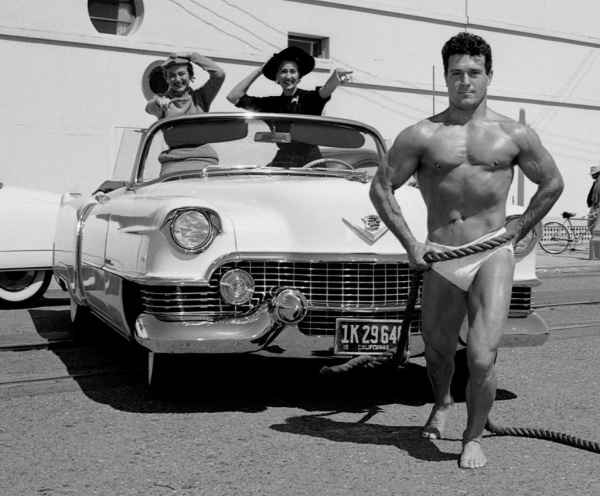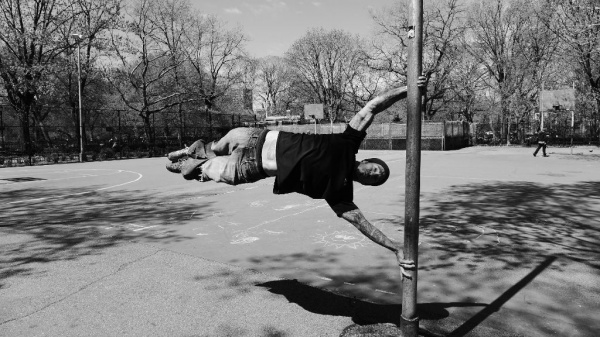Blood is life. Throughout the history of our world, gurus, shamans, medicine men, and hunters have drank blood straight from the carcass for celebration or ritual. The blood carries oxygen, nutrients, and protein–true life force–to the physical body. The blood transfers strength, soul, and virility to the spiritual body. Both literally and figuratively, it represents our very essence.
When we say that something is “in our blood,” we mean that we are deeply linked to it. We wouldn’t use those words unless we were talking about something that is a part of us, something that truly makes us who we are.
Body weight strength training is in my blood.
“When I was younger, I drank a quart of blood a day for about six weeks. I’d get it from the slaughterhouse.
I’d heard about the Masais… they’d drink cattle blood for strength.”
– Jack LaLanne

I am profoundly passionate about the pursuit of strength and well being. The path to a new skill, and the beauty and synchronicity of full-body harmony (all the components of Progressive Calisthenics) excite me. If they didn’t, I wouldn’t do it. I also love talking about training and exchanging ideas with others. It’s always a thrill to get together with like-minded individuals and share stories, as well as techniques and concepts.
I live for the thrill of the chase. Whether that means employing newly-learned tips for improving my L-sit or beginning to train weighted human flag, I love the challenge. But like everything in life, some of these challenges come easier than others.

The full one-arm pull-up is one skill that eludes me. I’ve come damn close. Many times, I’ve pulled and twisted from a dead hang ‘til my chin touched my wrist. I could taste the sweat. I could smell the bar. But my chin never cleared it… at least not with one arm. In 2006, getting a one-arm pull-up was my obsession.
Not surprisingly, I had my first serious bout with tendonitis in 2007. Don’t shed a tear for Danny; I’ll be the first to admit that I am not special at all for getting hurt. Just about everyone who trains hard in any capacity gets injured now and again. What we do is not for the meek. Whether it’s sprains, strains, breaks, or aches, every fitness aficionado I’ve ever known in my life has had to lay off it once in a while. It sucks.
But tendonitis always seems to linger a little longer than expected. It haunts you.
“It will cost you sweat and tears, and perhaps… a little blood.”
-from “Nosferatu”

Both Coach Wade in the Convict Conditioning series and my brother Al Kavadlo in Pushing The Limits specifically address the difference in recovery time between connective tissue (tendons in particular) and muscle. They both observe (spot on, as always) that tendons take much longer to repair themselves. I’m no stranger to danger. I know this stuff well from years of hard-won experience, but I never really thought to ponder why. I always had the philosophy that a few nicks and dings along the way were no big deal, so I didn’t examine injury much. Perhaps I should have.
Things changed this past year when I suffered from tendonitis… again. This time I thought “Gee, I really should know better.” What is it about those damned tendons anyway, and why do they adapt so much slower than muscle?
I was desperate. I saw a doctor for the first time in fifteen years, but as I expected, he couldn’t tell me anything I didn’t already know. After I filled out a lot of paperwork, he referred me to an orthopedist who turned out to be his buddy from medical school. I passed on that visit. I didn’t want to see another doctor.
I was about to make an appointment with an Eastern acupuncturist, when fate intervened and I had a chance phone call with a rabbi/chiropractor from Borough Park, Brooklyn. He broke it down for me:
“Lousy circulation.”
“What?”
“Lousy circulation,” he repeated.

He went on to explain that connective tissue has poor circulation compared to muscles. This lack of blood flow means fewer nutrients get to the tendons, hence a slower recovery time. Even though I knew how to treat my injury (mostly just leave it alone and let it heal,) the acquisition of this minute piece of trivia fascinated me. “It really is in my blood,” I thought. “Of course!”
Products like Tiger Balm and Icy Hot promote healing because they heat up the area to which they are directly applied. Blood flow increases to regulate the temperature. As a side effect, the blood administers the extra vitality needed to heal. Natural anti-inflammatories like turmeric and nutmeg also work by promoting circulation. As usual, it took something really simple to completely blow my mind.
These days the tendonitis is gone and both my elbows feel amazing. I’m pleased to say I am back, seeking new challenges with an unprecedented enthusiasm, and training harder than ever! How could I not?… it’s in my blood.
***
About Danny Kavadlo: Danny Kavadlo, Master PCC, is a Personal Trainer in New York City. He’s worked with hundreds of clients, including athletes, models, and celebrities. He is featured in the Convict Conditioning Series & Raising the Bar, and is known globally as a motivator & leader in the calisthenics community. Learn more about Danny at: www.DannyTheTrainer.com.